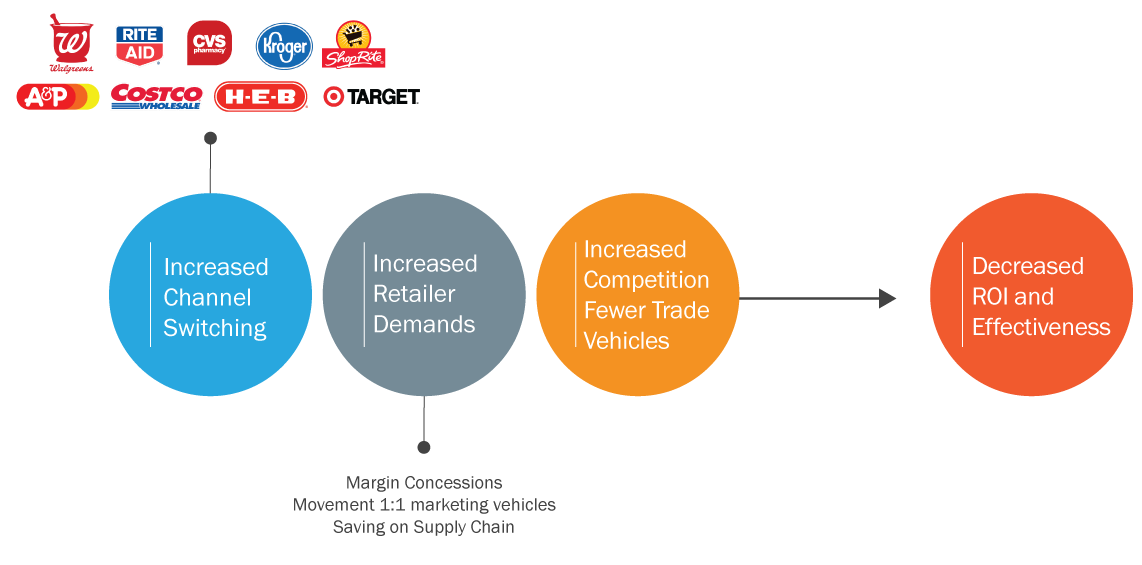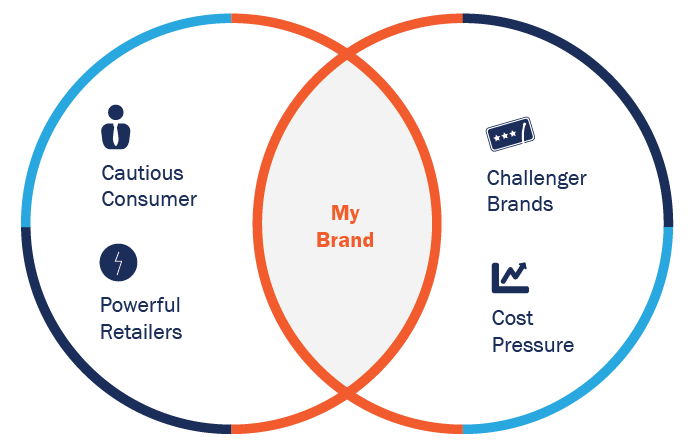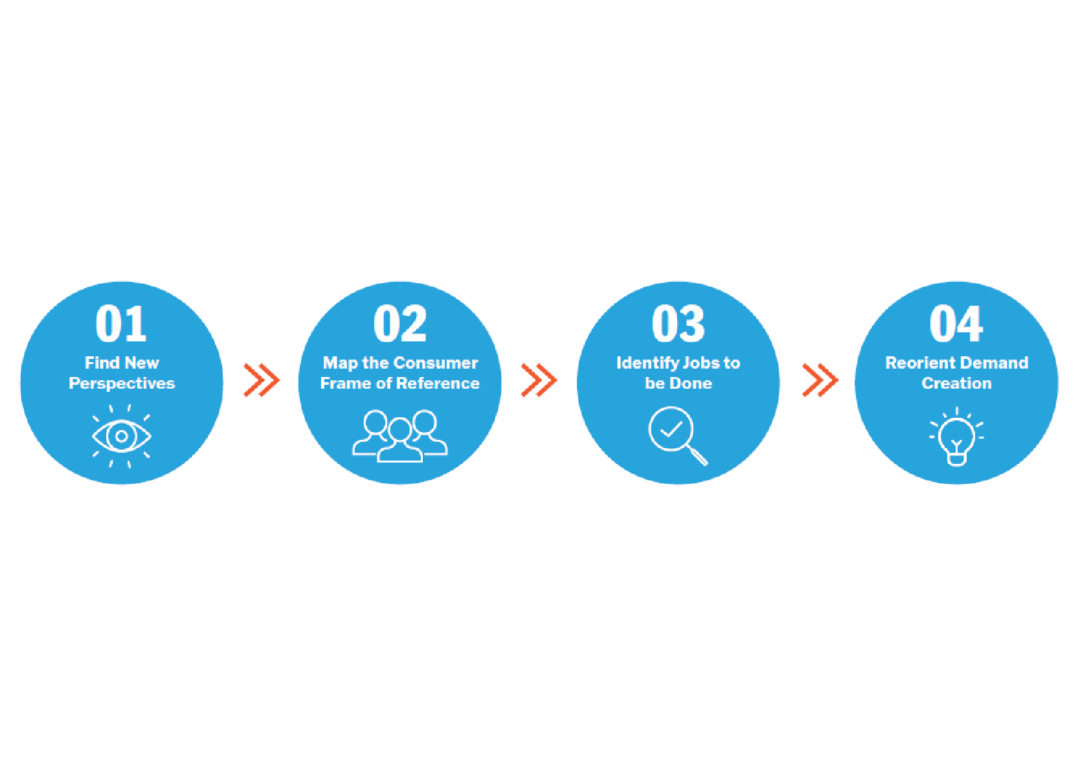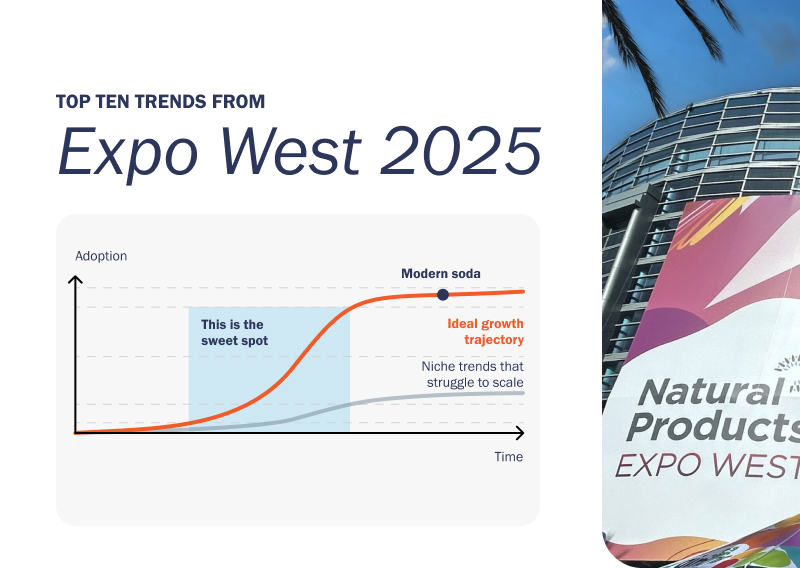Trade Promotion In Turmoil
Trade Promotion in Turmoil
Trade promotion continues to increase as manufacturers prop up short-term performance, fend off emerging competitors, and appeal to retailers’ demands to meet their category objectives.
Today, it is not uncommon for food and beverage manufacturers to have trade spending as a percent of sales climb above 25%. At these levels, trade spending can jeopardize brand equity and quickly commoditize categories.
The average trade event lift is down as the Ad vehicle becomes less effective, display less prominent; more retailers shift to a hybrid/EDLP strategy, and overlapping competitors promote during the same week.
The overall impact is return on trade investment is declining as every dollar invested in trade becomes
less efficient.
Trade spending is increasing at a rate faster than sales for many brands, creating a situation that must be addressed by brand owners in order to meet increasing profit targets.
Retailers are asking for greater manufacturer investment as they expand demand generation efforts through social and digital marketing vehicles to reach changing consumers through their preferred means of communication.
Left unchecked, trade spending ROI is forecasted to continue its decline due to key macro trends facing the Consumer Packaged Goods industry:

Spending power is unchanged for the majority of Americans as real wages remain flat, despite improving employment numbers.
Additionally, the lessons of the ‘Great Recession’ have left a lasting focus on value for consumers across the income spectrum.

Retailers across the market, from Dollar General to Whole Foods, need to be sharp on value and are resisting attempts by manufacturers to increase margin in the form of higher prices or lower trade investment.
Adjustments to trade spending are particularly difficult since manufacturer trade investment is the one item that swings retailers from a loss to profitability.

New challenger brands are driving growth across categories and are receiving favorable treatment by retailers desperate for topline growth.
Challengers come in many forms, including those offering big brand benefits for lower prices, and retailers’ own Private Label.

Increasing global demand for commodities, combined with disruption in the agricultural sector, is driving increased input costs for many products.
Manufacturers struggle to pass along cost increases through higher prices, and when implemented, these increases are often dialed back through increased trade investment.
Macro Trends Will Have Impact
These macro trends will impact all manufacturers that are not agile in adjusting how their trade funds are managed, integrated into the marketing plan, and deployed at retail.
As the #1 marketing lever to drive desired brand and category purchasing behaviors among shoppers, adjusting with the times is critical to meet performance goals.
A change in approach is particularly timely for brands in categories where organic topline growth is difficult to achieve. While topline growth may be slowing, the expectations of Wall Street are not changing, and increasing profit delivery is a must for managers.
Fortunately, trade spending is a lever that has an immediate impact on the P&L and it should be optimized to achieve financial and marketing objectives.
Best Practices
We recommended five best practices to counter the drag of macro forces and both increase the financial return on trade investment and ensure trade investment is strategically aligned with brand goals:

Examine trade program impact on shopper behavior in order to create a ‘common language’ to drive alignment between marketing strategy and trade strategy.
Key enablers of this practice are granular, shopper behavior insights at the point of purchase that serve as the ‘planning currency’ between sales and marketing.

Managers need to examine trade performance using more than volume and spending. A true profit view is critical for optimizing trade investment to have the greatest impact on the P&L.
A key enabler is identification of item level profitability and trade spending at the point of execution.
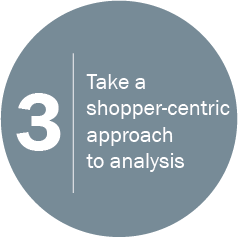
Shoppers are influenced by a wide variety of inter-related factors when making a product choice in store. These factors extend well beyond a ‘syndicated view’ of the store and include everything from shopper marketing programs to the way price messages are communicated at shelf (e.g.,“Save $1.00” vs. “$2.99”).
Manufacturers seeking to gain an edge over competition and increase the efficiency of spending need to incorporate all of these factors into trade analysis and identify the contribution of each factor in driving demand.

Optimizing trade based on year-over-year adjustments or event-by-event, post promotion analysis is no longer an option in a world where average event performance is decreasing.
Manufacturers need to widen their analytical approach to include all of the events/factors in their ‘universe’ in order to identify winning factors that can be more broadly exploited across the business along with NEW programs to bring to market.

Plan beyond a ‘Trade Program’ by taking a total demand generation approach. Integrate leading shopper marketing strategies, investment, and programming into a total customer demand plan for retail partners.
Conclusion
We see manufacturers who take a structured approach and utilize the five best practices above realize a 10X return on the investment required to conduct analysis and implement a change in strategy. In addition to its size and importance, optimizing trade programs enables manufacturers to have an immediate, positive impact on the P&L to achieve planning targets.
The Seurat Group’s TradeCatalyst™ approach is a flexible trade optimization framework that integrates a variety of data sources and combines trade analytics with deep shopper, competitor, and retailer insight to identify the optimal, integrated trade strategy. The approach helps manufacturers better utilize trade as a marketing tool and increase the return on every dollar invested in trade programs.
Contact the Seurat Group to learn more about ways to optimize trade promotion in order to increase sales and profit delivery: info@seuratgroup.com

